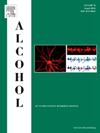Maternal, paternal, and dual-parental alcohol exposures result in both overlapping and distinct impacts on behavior in adolescent offspring
IF 2.9
4区 医学
Q3 PHARMACOLOGY & PHARMACY
引用次数: 0
Abstract
Emerging research reveals that alcohol use by fathers before conception can affect the growth and development of their offspring. Here, we used a C57BL/6J mouse model to study the effects of alcohol exposure on the behavior of the first-generation (F1) offspring, comparing the impacts of alcohol exposure by mothers, fathers, and both parents. Our goal was to determine how alcohol exposure by each parent or both parents influences the behavior of the offspring. We found that adolescent male offspring of alcohol-exposed fathers showed reduced anxiety-like behaviors as they spent more time in the center of the testing arena during the open field test. Both maternal and paternal alcohol exposure caused sex-specific increases in the nestlet shredding test while decreasing the number of buried marbles in the marble burying test. Interestingly, dual-parental alcohol exposure did not produce any significant changes in these same tests. However, during novel object recognition testing, we found that dual-parental male and female offspring exhibit an increased preference for novel objects, suggesting an increased risk preference. Finally, at sixteen weeks, male offspring of dual-exposed parents exhibited decreased voluntary physical activity on running wheels during the active phase, suggesting alterations in their circadian rhythms. Although differences in parental exposure histories between treatment groups make interpretation challenging, our findings suggest that exposure to alcohol by both parents may have unique effects on behavior and that studying both maternal and paternal alcohol use is essential for understanding the full range of factors influencing the penetrance and severity of alcohol-related phenotypes.
母亲、父亲和双亲酒精暴露对青少年后代的行为既有重叠的影响,又有不同的影响。
最新研究表明,父亲在怀孕前饮酒会影响后代的生长发育。在这里,我们使用C57BL/6J小鼠模型来研究酒精暴露对第一代(F1)后代行为的影响,比较了母亲、父亲和父母双方酒精暴露的影响。我们的目标是确定父母一方或双方的酒精暴露如何影响后代的行为。我们发现,酗酒父亲的青春期男性后代在开放场地测试中,当他们花更多的时间在测试场地的中心时,他们的焦虑行为就会减少。母亲和父亲的酒精暴露均引起雏鸟粉碎试验的性别特异性增加,而大理岩掩埋试验中掩埋大理岩的数量减少。有趣的是,双亲酒精暴露在这些相同的测试中没有产生任何显著的变化。然而,在新物体识别测试中,我们发现双亲双亲的雄性和雌性后代对新物体的偏好增加,这表明风险偏好增加。最后,在16周时,双暴露父母的雄性后代在活动阶段在跑步轮上的自愿体力活动减少,这表明他们的昼夜节律发生了变化。尽管治疗组之间父母接触史的差异使得解释具有挑战性,但我们的研究结果表明,父母双方都接触酒精可能对行为有独特的影响,研究母亲和父亲的酒精使用对于理解影响酒精相关表型外显率和严重程度的所有因素至关重要。
本文章由计算机程序翻译,如有差异,请以英文原文为准。
求助全文
约1分钟内获得全文
求助全文
来源期刊

Alcohol
医学-毒理学
CiteScore
4.60
自引率
4.30%
发文量
74
审稿时长
15.6 weeks
期刊介绍:
Alcohol is an international, peer-reviewed journal that is devoted to publishing multi-disciplinary biomedical research on all aspects of the actions or effects of alcohol on the nervous system or on other organ systems. Emphasis is given to studies into the causes and consequences of alcohol abuse and alcoholism, and biomedical aspects of diagnosis, etiology, treatment or prevention of alcohol-related health effects.
Intended for both research scientists and practicing clinicians, the journal publishes original research on the neurobiological, neurobehavioral, and pathophysiological processes associated with alcohol drinking, alcohol abuse, alcohol-seeking behavior, tolerance, dependence, withdrawal, protracted abstinence, and relapse. In addition, the journal reports studies on the effects alcohol on brain mechanisms of neuroplasticity over the life span, biological factors associated with adolescent alcohol abuse, pharmacotherapeutic strategies in the treatment of alcoholism, biological and biochemical markers of alcohol abuse and alcoholism, pathological effects of uncontrolled drinking, biomedical and molecular factors in the effects on liver, immune system, and other organ systems, and biomedical aspects of fetal alcohol spectrum disorder including mechanisms of damage, diagnosis and early detection, treatment, and prevention. Articles are published from all levels of biomedical inquiry, including the following: molecular and cellular studies of alcohol''s actions in vitro and in vivo; animal model studies of genetic, pharmacological, behavioral, developmental or pathophysiological aspects of alcohol; human studies of genetic, behavioral, cognitive, neuroimaging, or pathological aspects of alcohol drinking; clinical studies of diagnosis (including dual diagnosis), treatment, prevention, and epidemiology. The journal will publish 9 issues per year; the accepted abbreviation for Alcohol for bibliographic citation is Alcohol.
 求助内容:
求助内容: 应助结果提醒方式:
应助结果提醒方式:


